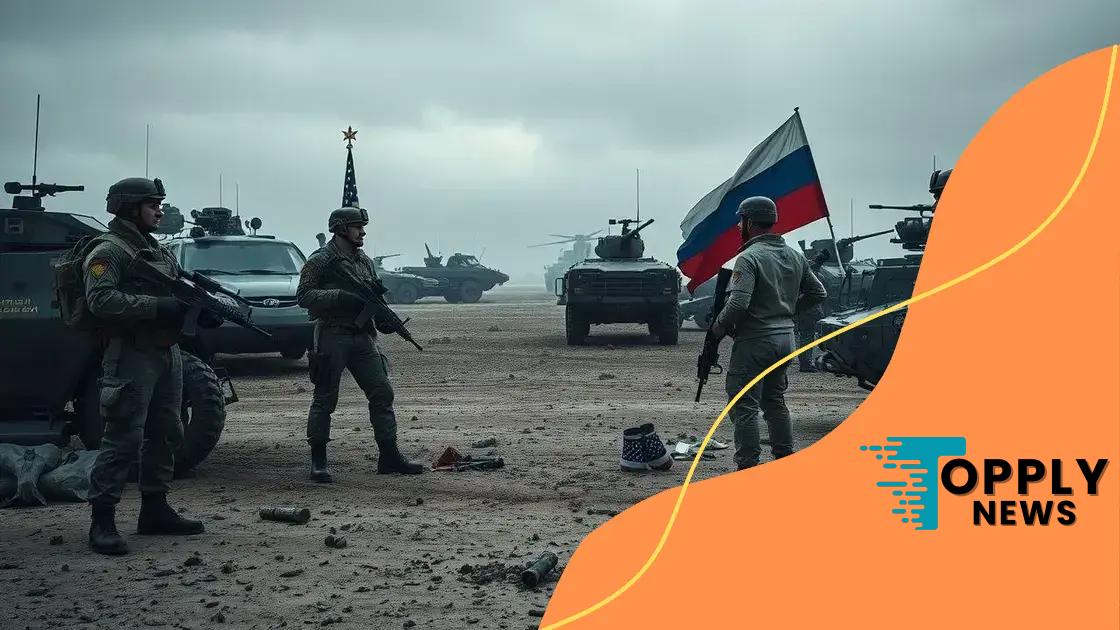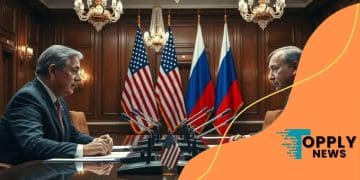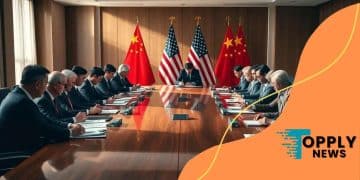US-Russia peace talks reduction: what it means for global stability

The reduction in US-Russia peace talks is primarily driven by increased political tensions, military posturing, and economic sanctions, making diplomatic resolutions more complex and challenging.
US-Russia peace talks reduction has become a focal point in international diplomacy. With tensions simmering, it’s vital to understand how this shift affects global stability and what it means for future negotiations. Curious about the broader implications? Let’s dive in.
Understanding the current state of US-Russia relations
Understanding the current state of US-Russia relations is essential for grasping global dynamics. Recent shifts have highlighted both tensions and opportunities for dialogue.
Brief Overview of US-Russia Relations
Historically, relations between the US and Russia have been complex and often contentious. From the Cold War to modern-day conflicts, the landscape is ever-changing. Today, issues like military presence, territorial disputes, and cyber threats play major roles in shaping these relations.
Key Factors Influencing Relations
- The Ukraine conflict has significantly impacted diplomatic ties.
- Economic sanctions imposed by the West have strained interactions.
- Mutual defense strategies and military exercises create a sense of mistrust.
- Both nations hold opposing views on international governance and human rights issues.
As these elements evolve, understanding the motivations behind each nation’s actions becomes critical. The US seeks to maintain its influence while Russia aims to assert its power on the global stage.
Recent diplomatic efforts indicate a willingness from both sides to engage in talks, despite ongoing disputes. Peace talks may provide a pathway to stability, but differing agendas complicate this process. Observers must remain aware of how these diplomatic maneuvers unfold.
In summary, the current state of US-Russia relations is characterized by a balance of tension and the potential for dialogue. Both nations face significant challenges, but the opportunity for change exists, depending on future interactions.
Historical context of peace talks between the US and Russia
The historical context of peace talks between the US and Russia reveals a complicated tapestry of negotiations, agreements, and conflicts. Understanding this background is crucial for grasping the current state of relations.
Cold War Era Negotiations
During the Cold War, both nations engaged in numerous talks aimed at reducing tensions. Key agreements like the Nuclear Non-Proliferation Treaty in 1968 sought to limit the spread of nuclear weapons. However, distrust often overshadowed these efforts.
Post-Cold War Relations
After the fall of the Soviet Union, the 1990s saw a thaw in relations, with several summits held to foster cooperation. The START treaties (Strategic Arms Reduction Treaty) were instrumental in reducing nuclear arsenals. Yet, lingering suspicions remained, often halting progress.
In the early 2000s, attempts to improve relations picked up again, yet events like the Georgia War in 2008 and conflicts in Syria strained diplomacy. Each incident pushed both nations to reassess their strategies. Throughout this timeline, various leaders have taken different approaches, impacting the direction of peace talks.
- Key milestones include the INF Treaty in 1987, which eliminated an entire class of nuclear weapons.
- The New START treaty, signed in 2010, further advanced arms control efforts.
- Recurring issues such as NATO expansion have continued to create friction.
As the 21st century progresses, historical lessons play a vital role in shaping contemporary dialogues. The US-Russia relations have seen cycles of harmony and discord, making it essential to learn from the past in order to navigate future challenges.
Key factors leading to the reduction in talks

Several key factors are leading to the reduction in talks between the US and Russia. By examining these issues, we can understand the challenges that impede diplomatic progress.
Political Tensions
One major factor is the rising political tensions between the two nations. Accusations of interference, particularly in elections, have fueled distrust. The rhetoric around these accusations often escalates, which makes meaningful dialogue difficult.
Military Posturing
Another significant factor is military posturing. Both countries continue to engage in extensive military drills and show of force, which can be interpreted as threats by the other side. This creates an atmosphere of fear and caution that hampers cooperation.
- Increased military budgets raise suspicions.
- Deployment of troops near borders creates tension.
- Cybersecurity threats add a layer of complexity.
Economic sanctions also play a critical role. Sanctions imposed due to various conflicts contribute to strained relations. These penalties often lead to retaliatory measures that solidify divides, making negotiations seem pointless or counterproductive.
Furthermore, both nations have divergent interests globally. For example, in regions like the Middle East, their conflicting strategies hinder constructive conversations. Each nation views the other’s actions as contrary to its own security and geopolitical goals.
Combined, these factors create a challenging environment for diplomacy. Moving forward requires recognizing these hurdles and striving for a more open channel of communication.
Potential global impacts of reduced US-Russia dialogues
The potential global impacts of reduced US-Russia dialogues can be profound and far-reaching. As two of the world’s leading powers, their interactions shape various aspects of international relations.
Increased Tensions in Global Hotspots
One significant impact is the likely increase in tensions in global hotspots. With reduced communication, misunderstandings can escalate into conflicts. Regions like the Middle East and Eastern Europe may see heightened military activity as both nations pursue their interests without sufficient dialogue.
Shifts in Alliances
Furthermore, a decrease in collaboration can lead to shifts in global alliances. Countries may feel the need to choose sides, aligning more closely with either the US or Russia based on their national interests. This can create new geopolitical blocs and alter existing alliances.
- Countries in Europe may seek stronger ties with the US for security.
- Russia may strengthen its relationships with nations like China and Iran.
- Smaller nations might leverage the tension to gain more influence.
Economic ramifications are also a possibility. Ongoing sanctions and trading restrictions can worsen, affecting global markets. Businesses that rely on international relations may find themselves in precarious positions, leading to economic instability in various regions.
Moreover, reduced dialogues may hinder efforts to address global issues like climate change. Cooperative initiatives that require collaboration and trust could stall, delaying progress on vital environmental goals.
The ripple effects of decreased US-Russia conversations could challenge global peace and security, raising concerns over national security for many countries around the world. Navigating these dynamics will require careful diplomacy and a commitment to open communication.
Alternatives for conflict resolution in the region
Exploring alternatives for conflict resolution in the region is essential as tensions between the US and Russia persist. Understanding different approaches can help foster dialogue and create more peaceful interactions.
Diplomatic Engagement
One effective method is enhancing diplomatic engagement. This involves open communication channels that encourage dialogue and negotiation. Regular meetings between leaders can help build trust and promote understanding, reducing the chances of conflicts escalating.
Multilateral Cooperation
Another alternative is to pursue multilateral cooperation. Involving international organizations, such as the United Nations or NATO, can bring a broader perspective to the table. These bodies can help mediate conflicts and offer frameworks for peaceful resolutions.
- Creating regional forums for discussion can facilitate collaboration.
- Engaging neutral countries as mediators may yield better outcomes.
- Working with non-governmental organizations to promote peace initiatives can help raise awareness and support.
Additionally, economic collaboration can serve as a foundation for peace. Promoting trade agreements and joint ventures between nations can create a sense of interdependence that discourages conflict. When countries benefit from each other economically, they may prioritize maintaining peaceful relations.
Grassroots efforts also play a vital role in conflict resolution. Encouraging dialogue at the community level can address local grievances, helping to prevent larger conflicts from arising. Engaging citizens in discussions about peace can empower them to become positive agents of change.
Ultimately, pursuing diverse pathways for conflict resolution can help pave the way for a more stable and peaceful region. Combining diplomatic efforts with grassroots initiatives and economic cooperation offers a robust approach to reducing tensions.
FAQ – Frequently Asked Questions about US-Russia Peace Talks and Conflict Resolution
What are the main reasons for the reduction in US-Russia dialogues?
Key reasons include rising political tensions, military posturing, and economic sanctions that create mistrust between the two nations.
How can diplomatic engagement help improve US-Russia relations?
Diplomatic engagement fosters open communication, which can help build trust and reduce misunderstandings that lead to conflict.
What role do international organizations play in conflict resolution?
International organizations, like the UN, can mediate conflicts and provide frameworks for cooperation, encouraging peaceful resolutions.
How can grassroots efforts contribute to peace?
Grassroots efforts promote dialogue within communities, allowing local grievances to be addressed and preventing larger conflicts from emerging.





